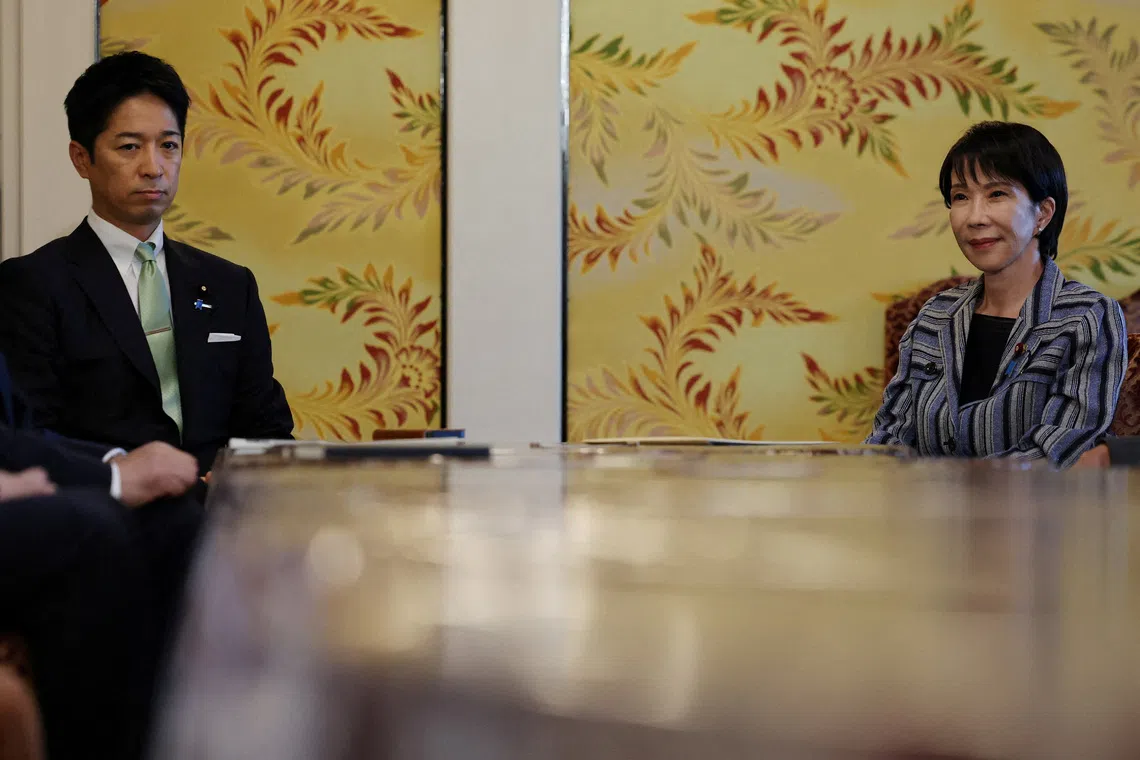Japan’s Ishin party joins political establishment it vowed to fight
Sign up now: Get insights on Asia's fast-moving developments

Japan Innovation Party's co-leader Fumitake Fujita meeting the leader of the ruling Liberal Democratic Party, Ms Sanae Takaichi, on Oct 17.
PHOTO: REUTERS
Follow topic:
TOKYO – Formed in 2010 to shake up Japan’s political establishment and loosen Tokyo’s administrative stranglehold, the Japan Innovation Party, known as Ishin, is now set to help the ruling Liberal Democratic Party (LDP) extend seven decades of dominance.
The opposition group from industrial Osaka, Japan’s No. 2 metropolis, said it is ready to ally with the LDP, all but guaranteeing its new hardline conservative leader Sanae Takaichi will become the country’s first female prime minister when Parliament picks a new premier on Oct 21
“Politics should be about taking risks when necessary to open up new paths,” Ishin leader and Osaka Governor Hirofumi Yoshimura said on Oct 20 during a television interview, as his party finalised its partnership deal with Ms Takaichi, albeit without sending any minister to her Cabinet.
It was, however, a “very difficult decision” because most parties that entered a coalition with the LDP “disappeared”.
Led by Mr Yoshimura from its western power base and co-leader Fumitake Fujita in Parliament, Ishin shares Ms Takaichi’s hardline stance on national security and immigration
Like Ms Takaichi, Mr Yoshimura and Mr Fujita want to rewrite Japan’s pacifist Constitution, expand a defence build-up aimed at deterring neighbouring China and impose stricter immigration controls. They have proposed a cap on foreign resident numbers and restrictions on property purchases by overseas investors.
The more moderate Komeito party quit its 26-year-old coalition
The LDP and Ishin also share an electoral problem: Each has lost or barely gained seats in Lower and Upper House elections held in the past year, whereas other conservative parties, including the far-right Sanseito, have surged.
Differences
To win voters back to a party rooted in Japan’s rural communities, Ms Takaichi has promised higher spending, which she says will revive the economy and support households squeezed by inflation.
The more market-oriented Ishin differs. Mr Fujita, a former gym instructor turned politician, and Mr Yoshimura, who rose to prominence directing Osaka’s Covid-19 response, are championing lower spending, tax cuts and smaller government.
Ishin on Oct 16 handed Ms Takaichi a list of 12 policy goals it wants to pursue. They include a one-tenth cut in parliamentary seats, social security reform, free high school education and a two-year pause to the consumption tax on food.
Mr Yoshimura has voiced support for legal changes to let women retain their surnames after marriage, a revision that social conservatives such as Ms Takaichi see as a threat to family unity, although Ishin has agreed to a more stopgap solution.
Mr Yoshimura also wants to designate his home town Osaka as a backup capital that could administer Japan if a major disaster crippled Tokyo.
At a press briefing on Oct 16, Mr Yoshimura said he would invite Ms Takaichi, who grew up in nearby Nara, to a parade in Osaka in November to celebrate the Hanshin Tigers baseball team’s Central League victory. If she accepts, it will be as prime minister.
Like Ms Takaichi, Mr Yoshimura calls himself a Tigers fan though, he says, “not as fanatical”. REUTERS

